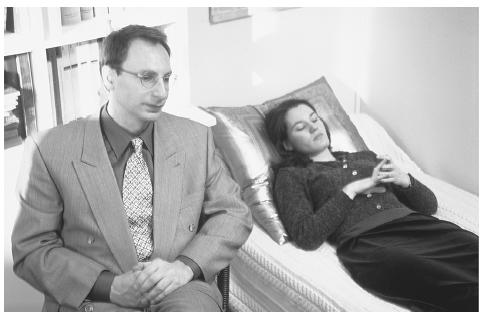Psychoanalysis

Definition
Psychoanalysis, as a form of therapy, is based on the understanding that human beings are largely unaware of the mental processes that determine their thoughts, feelings, and behavior, and that psychological suffering can be alleviated by making those processes known to the individual.
Sigmund Freud originally developed the theory and technique of psychoanalysis in the 1890s. Freud's ideas are still used in comptemporary practice; however, many have been further developed or refined and some even abandoned. The theory and technique of psychoanalyis contnues to integrate new insights about human development and behavior based on psychoanalytic research and discoveries from related fields. Different schools of psychoanalytic theory have evolved out of the original Freudian one, reflecting a variety of ideas and perspectives. Psychoanalysis is practiced by a trained psychoanalyst, also referred to as an analyst.
Purpose
Primary goals of psychoanalysis include symptom relief, increased self-awareness, and a more objective capacity for self-observation. Other aims might include improved relationships with others and the capacity to live a more deeply satisfying life. Typically, an individual seeks treatment in order to alleviate some difficulty, such as unhappiness in work or love, disturbances in mood or self-esteem, or troubling personality traits. With the exception of those that are physically based, psychoanalysis views such symptoms as related to unconscious mental processes, and because these mental forces are not within the individual's awareness, symptoms cannot be relieved with perseverance or with the help of friends or family. Through a slowly unfolding process, psychoanalysis demonstrates to the individual how unconscious mental processes affect current modes of thinking, feeling and interacting with others. It also demonstrates that these processes can be traced back to early experiences and relationships with caregivers and family members. This kind of insight enables the person to identify the sources of their sometimes troubling thoughts, feelings and behavior and, as a result, gives new meaning to current modes of functioning. This kind of transformation of character takes several years to accomplish due to the intense nature of the process. It requires a sacrifice of time, money, and mental energy. The resulting transformation offers the means for adaptive, enduring changes in

Precautions
The term "psychoanalyst" can be used by anyone, so it is important to know the credentials of an analyst prior to beginning treatment.
Credentials
In addition to having received advanced degrees in mental health (psychiatry, psychology, social work), trained psychoanalysts have also graduated from psychoanalytic training institutes. Institute training consists of three parts: course work on psychoanalytic theory and technique; supervised analyses (meaning that the candidate conducts analyses while being supervised by a seasoned psychoanalyst); and, third, candidates undergo a personal psychoanalysis. A personal analysis is considered a vital part of the training, as it enables candidates to learn about their own psychological processes. In turn, the knowledge enhances their capacity to treat others. This type of training program takes a minimum of four years to complete. Psychoanalysts also practice psychoanalytic psychotherapy , a less intensive form of treatment. It relies on the same theory of human development and a similar technique.
Description
In psychoanalysis, an individual in treatment is seen four to five times per week for 45- to 50-minute sessions. The individual lies comfortably on a couch while the analyst sits in a chair behind the person, out of view. The person is then asked to say whatever comes into his or her mind. Although this structure varies depending on the theory and style of the analyst, this is the most typical and traditional manner in which sessions are conducted. These conditions are maintained consistently, making it possible for thoughts and feelings to emerge that had once been outside of the person's awareness. The process of free associating, or saying whatever comes to mind, is challenging because people are taught at a young age to keep many ideas and feelings to themselves. When the analyst is out of view, it removes the possibility for eye contact, making it easier to speak spontaneously. Free association is also made easier by the analyst's nonjudgmental attitude—in listening to the individual, in the attention and interest given to seemingly unimportant details, and the objective and caring attitude with which the analyst understands the individual.
As the person speaks, unconscious sources of present-day difficulties gradually appear. Specifically, the analyst begins to notice repetitive aspects of behavior. Some of them may include particular subjects about which the person finds it hard to speak, as well as habitual ways in which the person relates to the psychoanalyst. The analyst begins to reveal these to the person in a gradual and thoughtful manner. Sometimes these revelations are accepted as correct and helpful. At other times they are rejected, corrected, or refined.
During the years of an analysis, the individual will grapple with new insights repeatedly, each time comprehending them in new ways. There will be an enhanced emotional and intellectual understanding, in addition to seeing matters from the perspective of different periods of life. As in all worthwhile learning processes, this one includes times of deep satisfaction and great frustration, periods of growth and regression. Overall, the analyst and individual work together to modify debilitating life patterns, to ameliorate troubling symptoms, and to release emotional and intellectual resources bound up in unconscious psychological processes. A transformation will occur eventually, and be one in which the person's understanding of themselves and of others, along with their productivity in work and capacity to love, changes in profound and enduring ways.
Who can benefit from psychoanalysis?
Anyone interested should seek a consultation with a psychoanalyst in order to determine if this treatment is appropriate. People often begin psychoanalysis also after having participated in psychoanalytic psychotherapy, which is a less intense form of treatment.
Individuals who are the most suited for psychoanalysis are those who have experienced satisfactions in work, with friends, in marriage, but who nonetheless experience a general dissatisfaction with their life—suffering from long-standing depression, anxiety, sexual difficulties, physical symptoms without physical basis, or typically feel isolated or alone. Some people need analysis because their habitual ways of living interfere with experiencing greater pleasure or productivity in life. Individuals need to be psychologically minded with an interest in becoming more self-aware, and a determination to forgo quick symptom relief in favor of a more gradual therapeutic process.
Psychoanalysis is also practiced with children and adolescents, with some variation in technique. Specifically, fantasy play and drawings are used with children in addition to verbal communication. During the treatment of children and young adolescents, parents are consulted on a regular basis so that the analyst can develop a more holistic understanding of the youngster's world. The goal of child and adolescent psychoanalysis is to alleviate symptoms and to remove any obstacles that interfere with normal development.
With other treatments
Psychoanalysis is used at times with other forms of treatment. Medication may be warranted in selected situations—if an individual suffers from a severe mood disturbance which interferes with his or her capacity to participate in treatment, for example. In general, medication is used as a tool that allows the individual to benefit from the psychoanalytic process; it is an adjunct therapy, while psychoanalysis is the primary curative one. There are also occasions in which psychoanalysis is provided concurrently with couples therapy or family therapy or with group therapy . Treatment recommendations, whether for psychoanalysis alone or in combination with couples, family, or group therapy, are based both on the individual's particular needs and the practice of the treating psychoanalyst.
Finally, psychoanalysis is not only a type of therapy. It is also a theory of human development from infancy to old age, a method for understanding thought processes. It offers a way of thinking about aspects of society and culture such as religion, prejudice, and war.
Normal results
Normal results include symptom relief and an enduring, adaptive change in personality.
Abnormal results
Some individuals do not benefit from this in-depth form of treatment. They instead experience increased distress, or do not progress after a sufficient amount of treatment sessions have elapsed. In these cases, people are typically transitioned to a less intensive form of treatment such as psychoanalytic psychotherapy.
Resources
BOOKS
Galatzer-Levy, Robert, M.D. Does Psychoanalysis Work? New Haven: Yale University Press, 2000.
Mitchell, Stephen A. and Margaret J. Black. Freud and Beyond. New York: Basic Books, 1995.
Oldham, John M., M.D. "Combining Treatment Modalities." In Textbook of Psychoanalysis, edited by Edward Nersessian, M.D. and Richard G. Kopff Jr., M.D. Washington, DC: American Psychiatric Press, Inc.,1996.
Weinshel, Edward M., M.D. and Owen Renik, M.D. "Psychoanalytic Technique." In Textbook of Psychoanalysis edited by Edward Nersessian, M.D and Richard G. Kopff, Jr., M.D. Washington, DC:American Psychiatric Press, Inc., 1996.
ORGANIZATIONS
American Psychoanalytic Association. 309 East 49th Street, New York, NY 10017. (212) 752-0450. <http://www.apsa.org> .
International Psychoanalytical Association. Broomhills, Woodside Lane, London N128UD.
Susan Fine, Psy.D
Comment about this article, ask questions, or add new information about this topic: